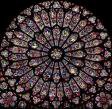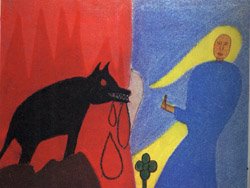 This is essentially, an edited out section of the last episode on the Six Grandfathers and American history.
This is essentially, an edited out section of the last episode on the Six Grandfathers and American history.Current research shows that on the day of birth a baby boy will look at a mobile hanging above his bead. A baby girl will look at a face. The one is a techomatrix orientation and inate fascination with technicality (head), the other empathy (heart). Head and heart are biological divisions and they are binary yang and yin orientations in
 the world. All societies divide between head and heart. Paris (above, Ile de la Cite and Left and Right Banks with Notre Dame's Rose Glass superimposed on the Ile de la Cite) gives a perfect example: the bankers and burgers live on the Right Bank of the river Seine (in red) and the artists, writers, hippies and mystics live on the Left Bank (in blue). The two halves are divided by a river connected by the Pont Neuf and held together by a perfect jewel: The Notre Dame Cathedral with its rose glass on the Ile de la Cite.
the world. All societies divide between head and heart. Paris (above, Ile de la Cite and Left and Right Banks with Notre Dame's Rose Glass superimposed on the Ile de la Cite) gives a perfect example: the bankers and burgers live on the Right Bank of the river Seine (in red) and the artists, writers, hippies and mystics live on the Left Bank (in blue). The two halves are divided by a river connected by the Pont Neuf and held together by a perfect jewel: The Notre Dame Cathedral with its rose glass on the Ile de la Cite. A distinct binary relationship can be seen extending across Asia as well from
The Asian regions developed these relationships over thousands of years, but the entire region will lose its internal yin/yang features as East and West adjoin in our times and a new global relationship develops a new Jewel Heart between East and West, founding a new benign mandala vortex around the Chicago/Toronto area thereabouts. This is a new world picture which has been moving to this one point since the beginning of civilization. It is the Aquarian mandala.
 There is a well-known analysis in psychiatric lore about "Henry’s dreams" (picture here from Man and His Symbols, edited by C.G. Jung), which refers to a long series of archetypal dreams that brought a psychiatric patient of C.G. Jung associate Jolande Jacobi to face deep and irrational powers within himself. During analysis, Henry drew a picture with a blue field on the right with a Madonna-like woman standing in it and a red field on the left with a wolf-like black monster in it. The picture suggests that the forces within Henry are dangerously incompatible, but in the center of the picture is a mandala-like flower which links the opposite sides.
There is a well-known analysis in psychiatric lore about "Henry’s dreams" (picture here from Man and His Symbols, edited by C.G. Jung), which refers to a long series of archetypal dreams that brought a psychiatric patient of C.G. Jung associate Jolande Jacobi to face deep and irrational powers within himself. During analysis, Henry drew a picture with a blue field on the right with a Madonna-like woman standing in it and a red field on the left with a wolf-like black monster in it. The picture suggests that the forces within Henry are dangerously incompatible, but in the center of the picture is a mandala-like flower which links the opposite sides.
 This personal dream of Henry's classically illustrates the situation described in the illustration above on the banks of the Seine in
This personal dream of Henry's classically illustrates the situation described in the illustration above on the banks of the Seine in  reveals that this is the same pattern on the flag of
reveals that this is the same pattern on the flag of
 Many flags, particularly in mature countries, have this same balance; the blue sometimes green and the red sometimes orange, and with a flower or an icon of some type in the center holding them together. (The icon stashed up in the corner and with only one color suggests a transitional phase or a country out of balance.)
Many flags, particularly in mature countries, have this same balance; the blue sometimes green and the red sometimes orange, and with a flower or an icon of some type in the center holding them together. (The icon stashed up in the corner and with only one color suggests a transitional phase or a country out of balance.)
1 comment:
Cool site
Post a Comment